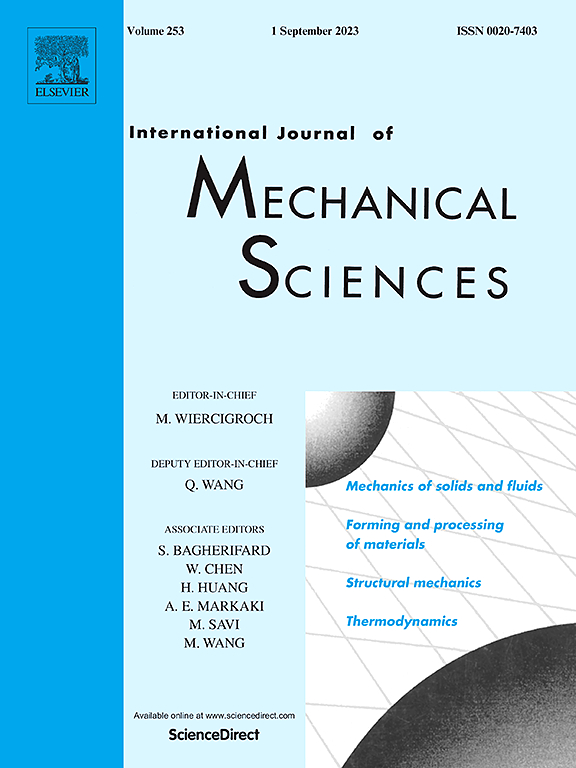具有两相特性的TA32合金超塑性本构模型
IF 7.1
1区 工程技术
Q1 ENGINEERING, MECHANICAL
International Journal of Mechanical Sciences
Pub Date : 2025-04-30
DOI:10.1016/j.ijmecsci.2025.110298
引用次数: 0
摘要
本研究提出了一个基于物理的本构模型来定量描述近α TA32钛合金在超塑性有利变形条件下的宏观力学行为和动态两相组织演变。观察了合金的微观形貌和取向,包括α- β相变、初生α (αp)和母晶β晶粒尺寸的稳态演化和动态粗化、α相内同时发生的不连续动态再结晶(DDRX)和连续动态再结晶(CDRX)以及α- ti晶格的结晶取向稳定性。结果表明,晶界滑动(GBS)在超塑性变形中占主导地位。根据确定的两相组织特征和变形机制建立了超塑性本构模型,阐明了相分数、晶粒尺寸、动态再结晶(DRX)分数和位错密度在给定塑性应变变化下的关系。该模型考虑了TA32合金两相的位错密度和相长大对β晶粒尺寸的影响,有效地描述了TA32合金在超塑性变形过程中的两相流动行为。此外,将该模型应用到VUMAT子程序中,建立了一个有限元(FE)模型,能够准确预测单轴拉伸试样的形状和微观组织分布。仿真结果显示了稳态晶粒尺寸,并证明了在校准范围内外的流动应力和速率相关的内部状态变量的出色预测能力。利用该模型模拟了锥体晶格结构的超塑性成形过程,成功地捕捉了几何复杂的TA32合金零件成形过程中α/β相特征的演变过程。本文章由计算机程序翻译,如有差异,请以英文原文为准。

Superplastic constitutive modeling of TA32 alloy with two-phase characteristics
This study proposes a physically-based constitutive model to quantitatively describe both macro-mechanical behavior and dynamic two-phase microstructure evolution of near-α TA32 Ti alloy under superplasticity-favored deformation conditions. The alloy’s microstructure morphology and orientation were observed, encompassing the α to β phase transformation, the steady-state evolution and dynamic coarsening of primary α (αp) and parent β grain sizes, the simultaneous occurrence of discontinuous dynamic recrystallization (DDRX) and continuous dynamic recrystallization (CDRX) within α phase, and crystallographic orientation stability of the α-Ti lattice. It is demonstrated that grain boundary sliding (GBS) predominates in superplastic deformation. The superplastic constitutive model was developed following the identified two-phase microstructure characteristics and deformation mechanisms, elucidating the relationships among phase fraction, grain size, dynamic recrystallization (DRX) fraction, and dislocation density, while given variations in plastic strain. This model effectively describes the two-phase flow behavior of TA32 alloy during superplastic deformation, considering the dislocation densities of both phases and the effect of phase growth on β grain size. Furthermore, this model was implemented into the VUMAT subroutine to develop a finite element (FE) model enabling accurate prediction of the shape and microstructure distribution in uniaxial tensile specimens. The simulation results show a steady-state grain size and demonstrate excellent predictive capabilities for flow stress and rate-dependent internal state variables both within and outside the calibration range. The superplastic forming (SPF) process of a pyramidal lattice structure was simulated using this model, successfully capturing the evolution of α/β phase characteristics during the forming of geometrically complex TA32 alloy components.
求助全文
通过发布文献求助,成功后即可免费获取论文全文。
去求助
来源期刊

International Journal of Mechanical Sciences
工程技术-工程:机械
CiteScore
12.80
自引率
17.80%
发文量
769
审稿时长
19 days
期刊介绍:
The International Journal of Mechanical Sciences (IJMS) serves as a global platform for the publication and dissemination of original research that contributes to a deeper scientific understanding of the fundamental disciplines within mechanical, civil, and material engineering.
The primary focus of IJMS is to showcase innovative and ground-breaking work that utilizes analytical and computational modeling techniques, such as Finite Element Method (FEM), Boundary Element Method (BEM), and mesh-free methods, among others. These modeling methods are applied to diverse fields including rigid-body mechanics (e.g., dynamics, vibration, stability), structural mechanics, metal forming, advanced materials (e.g., metals, composites, cellular, smart) behavior and applications, impact mechanics, strain localization, and other nonlinear effects (e.g., large deflections, plasticity, fracture).
Additionally, IJMS covers the realms of fluid mechanics (both external and internal flows), tribology, thermodynamics, and materials processing. These subjects collectively form the core of the journal's content.
In summary, IJMS provides a prestigious platform for researchers to present their original contributions, shedding light on analytical and computational modeling methods in various areas of mechanical engineering, as well as exploring the behavior and application of advanced materials, fluid mechanics, thermodynamics, and materials processing.
 求助内容:
求助内容: 应助结果提醒方式:
应助结果提醒方式:


